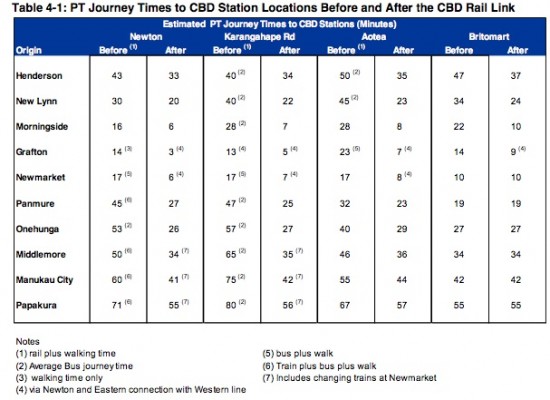Time CDB Loop Will Save You
From a commuter point of view, the CBD link is a no-brainer.
Have a look at the table of travelling times benefits alone in the business case. In particular, rail services from the west of Auckland will have a more direct route to the CBD, by eliminating the need to travel via Newmarket as at present.
And with Auckland’s CBD growth, people won’t be far away from a train.

Operational simulations of the CBD Rail Link by KiwiRail indicate that the theoretical capacity of the rail link between Britomart and Mt Eden, is between 15 and 30 trains per hour in each direction, depending on the configuration of the signalling system which is provided. This would provide the maximum available hourly passenger carrying capacities shown here.
Transport modelling indicates the CBD Rail Link will dramatically alter the flow of passengers moving around the Auckland CBD, with wider transport network and economic development impacts.
This table summarises the passenger flows generated from the APT transport model for the CBD Rail Link configured with three stations, consistent with the base option electric service pattern discussed above. The first column looks at the flows of people on the rail network around the stations (on trains travelling in both directions), while the other three columns summarise station usage.
The busiest part of the network in the 2041 2-hour morning peak would be the eastern approach to Britomart, with around 17,700 passengers.
Flows on the Rail Link itself are forecast to be around 15,700 passengers on either side of Aotea station and 16,200 passengers where it leaves the Western Line.
The implications of this include:
- the new station at Aotea is forecast to become the busiest station on the network, with almost 12,000 passengers every peak compared to 9,000 at Britomart by 2041
- the three new stations in total are forecast to have over 20,000 passengers every peak in 2041
- annual rail patronage with the CBDRL is forecast to reach 50 million by 2041, more than twice what it would be if the Link wasn‟t built
- the CBDRL will remove around 15 million car-kilometres from the network in the year 2041.
Forecasts using APT modelling indicate that the number of AM peak passengers using “K” Road station would be around 5,500 and the equivalent figure for Newton is 3,300. The Newton station also serves as a significant transfer point for passengers changing trains between services using the CBD Rail Link and services operating to Newmarket via Grafton. However, these figures take no account of the expected regeneration impact of the stations the APT model has no feedback mechanism from the network to land use. In practice, the presence of the stations would lead to development in the vicinity and this would considerably increase the ridership over these forecasts.
The topography of central Auckland, together with the operational constraints for rail vehicles, results in the CBD Rail Link having steep gradients and deep underground stations over most of its route. There is an approximate 76 metre difference in elevation between Britomart and the Western line at Mt Eden; in addition, the tunnels have to pass at sufficient depth beneath the Central Motorway Junction to avoid impacting motorway operations.
Twin tunnels, each having an outside diameter of approximately 7 metres, will be provided, and connected by cross passages at a minimum spacing of 240 metres, for evacuation purposes. The tunnels will be constructed by a combination of Tunnel Boring Machines and Cut and Cover construction methods.
The three stations have provision for underground island platforms (maximum 170 metres long or equivalent to a 7 car long train), connected to subsurface concourses via escalators and lifts. The station depths vary between 18 metres below the surface at Aotea and 43 metres below ground at Newton.
Post electrification, passenger services will be operated largely by electric multiple unit (EMU) trains (6 cars long on all routes except for 3 cars on the Onehunga line), with a planned seated plus standing capacity of 385 for a 3 car EMU and 770 for a 6 car. Therefore ARTA‟s proposed 20 tph service would provide an hourly carrying capacity of around 16,100- 16,200 passengers into Britomart, although the actual number of CBD passengers able to be transported by rail will in practice be determined by the number of passengers travelling to intermediate destinations such as Newmarket.
The current configuration of Britomart appears to provide adequate capacity into the CBD for rail passengers in the future; however, Britomart’s position on the northern periphery of the CBD effectively limits the catchment for CBD rail journeys to those passengers travelling to destinations within 400-500m distance of Britomart. The rail development plan provides for the current upgrading and capacity improvements to the existing Auckland rail network (these are in progress), enabling the delivery of more passengers.
Outside of Britomart however, the new post electrification signalling system will provide for the following maximum numbers of trains to be operated per hour.
The addition of the CBD Rail Link would offer better exploitation of these improvements through penetration of the central and southern parts of the CBD, extending the service that can be provided for rail passengers. Through-routing at Britomart not only would allow for capacity utilisation, but also would afford better network optimisation from flexibility in services patterns and scheduling.
Coverage continues:
What’s in Case study and how it will unlock Auckland’s potential
Len Brown -I want it in 7 years
Watch Len Brown’s news conference
Chinese interest in CBD loop














1 Comments
this project will be especially transformational for the inner west, the area from New Lynn - Kingsland.
Already a fair number of people catch the train from
Britomart to Kingsland, however now the journey time will only be 10mins to Britomart the effect will be amazing here.